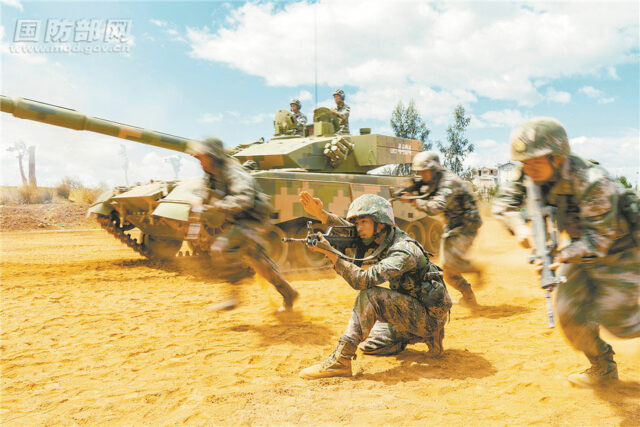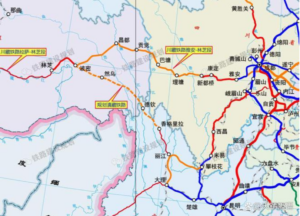Suyash Desai

Introduction
Soon after Xi Jinping assumed charge as the Central Military Commission (CMC) Chairman in November 2012, he set the stage for a sweeping military restructuring. On February 1, 2016, the People’s Liberation Army (PLA) moved away from the old Soviet-inspired Military Regions (MR) system to the U.S.-inspired Theater Command (TC) model. Under this new model, the seven Military Regions—Shenyang, Beijing, Jinan, Nanjing, Guangzhou, Chengdu and Lanzhou—were reorganized into five geographic TCs, each with a specific “strategic direction” (战略方向). [1]
Following the force restructuring, the three TCs that concern India are the Western Theater Command (WTC) along with Tibet and Xinjiang Military Districts (TMD and XMD), the Southern Theater Command (STC) and the Central Theater Command (CTC). WTC’s 76th and 77th Group Armies (GA) under the PLA Army’s (PLAA) jurisdiction are mandated to ensure the security of China’s land boundaries with Central Asian states, India, Nepal, and Bhutan. The TMD and XMD were retained to oversee security on the Chinese border with the Indian state of Arunachal Pradesh and the Union Territory of Ladakh, respectively. In addition to the PLAA, the PLA Air Force (PLAAF), the PLA Rocket Force (PLARF) and the PLA Logistic Support Force (JLSF) are also significant services under the WTC command, while the PLA Navy (PLAN) plays a minor role at Pangong Tso in the Aksai Chin region. Elsewhere, PLAN forces under the STC’s jurisdiction are responsible for securing Chinese interests not only in the South China Sea but also possibly in the Indian Ocean Region and the Western Pacific Ocean. The CTC is mandated to protect the capital but also acts as an anchor to provide additional troops to other theaters in case of a contingency, including WTC. This is an important division of responsibilities for the Chinese armed forces after Xi’s recent military reforms. [2]
However, recent developments have highlighted that the STC’s 75th Group Army could also play an important role in securing the People’s Republic of China’s (PRC) territorial integrity in Tibet, especially in the eastern sector bordering the Indian state of Arunachal Pradesh. Furthermore, the troops from the STC’s 75th Group Army could be used for rotation in the Tibetan theater, and the 75th GA’s artillery could be mobilized during a contingency with India. The four major reasons that the STC’s 75th GA could play such a role are improving connectivity between Tibet and the Southwestern Chinese province of Yunnan, minor changes to the 75th GA’s force composition, recent military exercises by STC’s 75th GA in Tibet and historical precedent.
Improving Tibet-Yunnan Connectivity
China has recently announced the construction of the Bomi-Ranwu (波密-然乌) sections of the Yunnan-Tibet railway (United Daily News, February 9). [3] This railway line will pass through Shangri-La, Dechen, and meet the Sichuan-Tibet railway at Bomi. The line will be extended up to Kunming, the capital of Yunnan province. On completion, it will connect Kunming, Chuxiong, Dali, Lijiang, Shangri-La, Deqin, Markam, Bomi, Nyingchi, Tsetang, Gonggar and Lhasa (see figure 1). Nyingchi is the closest point on the route to the Indian border, and this line is further integrated with the upcoming wider Tibetan railway network, which runs parallel to the Indian border across Tibet and reaches Hotan in Xinjiang, possibly passing through the disputed Aksai-Chin region.[4]
Figure 1: Chinese Railway Infrastructure Connecting Yunnan and Tibet

The completion of this rail line will reduce the distance from Dali, Kunming, Kaiyuan, and Lancang to Tibet. These cities in Yunnan host the PLA 75th GA’s major installations. Dali has a PLA mechanized infantry brigade, Kaiyuan hosts an infantry brigade, Lancang has an infantry brigade and Kunming has infantry, artillery, air defense and armored brigades (China Brief, July 22, 2016). These units were previously part of the 14th Corps, which was later reorganized as the 14 Group Army (GA) before being incorporated into the 75th GA under the STC. The 75th GA is currently garrisoned in the Yunnan province.
The construction of the Tibet-Yunnan railway network will be completed by 2030. Upon its completion, travel time between the two regions will be reduced by half, allowing for quicker mobilization of forces. In comparison to mobilizing forces from the CTC, which acts as a reserve force for every TC, including the WTC, mobilization of the 75th GA to Tibet would be relatively faster. Also, given the relatively high altitude at which troops in the 75th GA are stationed in the Yunnan-Guizhou Plateau region, their acclimatization to Tibet’s climatic conditions would be relatively easy in comparison to the Beijing-based CTC.
New Capabilities, Changing Force Composition
In addition to benefiting from new infrastructure connecting Tibet and Yunnan, the force composition of the 75th GA is also changing. In December, the PLA commissioned newer rocket launchers, howitzers and anti-aircraft guns for the 75th GA (Sohu, December 9, 2022). This includes the FN-16/Hongying-6B anti-aircraft missile (also called “625” anti-aircraft guns) and 122mm rocket launchers. Earlier in 2022, these new “625” anti-aircraft guns were spotted training in the TMD. This ordinance is mobile, long-ranged and has comprehensive firepower coverage.
Furthermore, the 75th GA’s 32nd Mountain combined arms brigade and 123rd heavy combined arms brigade have also recently commissioned Type 15 light battle tanks (Janes, September 22, 2020). In comparison to the Type 99 and Type 96, the two major tank types in the PLA, the Type 15 is significantly lighter, weighing about 32-35 tons. Due to their lightweight and speed, it is easier for such tanks to operate in the plateau region. The first batch of this tank was commissioned with the XMD (South Xinjiang Military Command) bordering the Indian Union Territory of Ladakh near Aksai Chin (Sohu, February 1, 2021). The 75th GA has also added an armored brigade to its inventory in the past two years, bringing the total number of brigades to four. [5] Moreover, the PLA has installed an Air Assault Brigade (AAB) with the 75th Group Army, which could be used in the east (Taiwan/South China Sea) or west (India-China border)—depending upon the requirement (Institute for National Defense and Security Research (Taiwan), January 15, 2021).
Modern equipment like “625” anti-aircraft guns, 122mm rocket launchers, and Type 15 tanks are believed to be generally commissioned with at least a medium-sized combined arms brigade or larger unit. The anti-aircraft guns and rocket launchers are responsible for air defense missions against various low-altitude aircraft, including armed helicopters and small drones. However, such forces are not of major use in the Yunnan region, as the China-Myanmar border is stable, demarcated and not disputed. Although the border region has occasionally been in the news due to insurgencies in Myanmar’s Kachin and Shan provinces, such issues primarily concern cross-border infiltration, which falls under the jurisdiction of the border defense units and Chinese People’s Armed Police and does not call for the involvement of PLA artillery or air defense units. Thus, the possible explanation for such explosive firepower with this GA could be for quicker mobilization of forces to Tibet during an escalation on the India-China border.
Recent Military Exercises
Several instances of units with the 75th GA undertaking training-specific routines in Tibet have recently been reported. In November 2021, the 75th GA’s air assault brigade conducted a joint flight training on the Western Sichuan Plateau, Southwest China, with an elevation of more than 4,000 meters (China Military Online, November 19, 2021). This was the first time that the brigade’s helicopter element held training exercises focusing on all-domain operation capabilities in this region. In May 2022, a 75th GA brigade was also involved in mobilization and acclimatization training for the troops at high altitudes in Tibet (Sohu, May 19, 2022). Furthermore, the 75th GA’s air defense brigade and the TMD’s army aviation brigade recently conducted joint land-air confrontation training in the region. These are just a few reported instances of the 75th GA’s training in the region, occasionally with the TMD. This is an evolving trend and more such instances of STC’s 75th GA training in the region, performing mobilization or acclimatization drills or training with TMD or WTC, are possible in the future.
Historical Precedents
Historically, PLA units based out of Kunming have been mobilized during insurgencies in Tibet and have also participated in border problems with India. For instance, elements of the 14th Corps, which was garrisoned in the Kunming MR, were mobilized during the PRC’s crackdown on the Tibetan uprising in 1959. [6] The 14th Corps was later reorganized as the 14th Army in 1985 and was one of the four armies under the Kunming and Chengdu MRs to guard China’s southwestern flank against India. Troops from the Kunming MR were deployed at the front on the border with India, while the Chengdu MR, currently WTC’s headquarters, assumed a reserve role. However, in the 1980s, the Kunming MR was revoked of its designation and the Chengdu MR incorporated some units from the Kunming MR. Thus, there is a historical precedent of mobilization of troops from Kunming during contingencies on the India-China border in Tibet.
Besides these four major reasons, in a recent article on the Chinese website Sohu, there were questions raised if two GAs with WTC—the 76th GA and 77th GA—are sufficient for providing security to the vast geographic scope of WTC (Sohu, January 16). The article’s tone indirectly criticized the recent force restructuring and raised questions as to whether these two GAs could manage such a vast geographic region.
Conclusion
Based on these four trends, the STC’s 75th GA is likely mobilized on the India-China border in Tibet in the event of a military contingency. The role of the 75th GA remains unclear. It could be used as a backup to WTC in place of CTC. As in the past, it could also be deployed ahead of WTC, and the forces from WTC could be used as reserve forces. The 75th GA’s artillery could also play a major role on the India-China border. Moreover, troops with this GA could also be used for rotation, as acclimatization is relatively more straightforward going from Yunnan to Tibet. These possibilities make STC’s 75th GA a critical future threat to monitor for India.
No comments:
Post a Comment